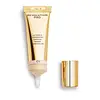Bobbi Brown Skin Corrector Stick Versus Revolution Beauty Revolution Pro Ultimate Coverage Crease Proof Concealer
What's inside
What's inside
 Key Ingredients
Key Ingredients

 Benefits
Benefits

 Concerns
Concerns

No concerns
 Ingredients Side-by-side
Ingredients Side-by-side

Glyceryl Triacetyl Ricinoleate
EmollientOctyldodecanol
EmollientBis-Diglyceryl Polyacyladipate-2
EmollientPolyethylene
AbrasiveOzokerite
Emulsion StabilisingKaolin
AbrasiveCI 77120
Cosmetic ColorantCalcium Aluminum Borosilicate
Caprylic/Capric Triglyceride
MaskingTocopheryl Acetate
AntioxidantSalicornia Herbacea Extract
Skin ConditioningCommiphora Mukul Resin Extract
Skin ConditioningCoffea Arabica Seed Oil
MaskingLecithin
EmollientBHT
AntioxidantPhenoxyethanol
PreservativeCI 77891
Cosmetic ColorantCI 77491
Cosmetic ColorantCI 77492
Cosmetic ColorantCI 77499
Cosmetic ColorantCI 77163
Cosmetic ColorantGlyceryl Triacetyl Ricinoleate, Octyldodecanol, Bis-Diglyceryl Polyacyladipate-2, Polyethylene, Ozokerite, Kaolin, CI 77120, Calcium Aluminum Borosilicate, Caprylic/Capric Triglyceride, Tocopheryl Acetate, Salicornia Herbacea Extract, Commiphora Mukul Resin Extract, Coffea Arabica Seed Oil, Lecithin, BHT, Phenoxyethanol, CI 77891, CI 77491, CI 77492, CI 77499, CI 77163
Bis-Diglyceryl Polyacyladipate-2
EmollientOctyldodecanol
EmollientCaprylic/Capric Triglyceride
MaskingSilica Dimethyl Silylate
EmollientOzokerite
Emulsion StabilisingTridecyl Trimellitate
EmollientPolyethylene
AbrasiveStearalkonium Hectorite
Gel FormingPropylene Carbonate
SolventTocopheryl Acetate
AntioxidantPentaerythrityl Tetraisostearate
EmollientEthylhexyl Palmitate
EmollientTribehenin
EmollientSorbitan Isostearate
EmulsifyingTrihydroxystearin
Skin ConditioningButylene Glycol
HumectantSodium Chondroitin Sulfate
Skin ConditioningCaprylyl Glycol
EmollientAtelocollagen
Skin ConditioningSodium Hyaluronate
HumectantHexylene Glycol
EmulsifyingPalmitoyl Oligopeptide
CleansingPhenoxyethanol
PreservativeCI 77891
Cosmetic ColorantCI 77492
Cosmetic ColorantCI 77491
Cosmetic ColorantCI 77499
Cosmetic ColorantBis-Diglyceryl Polyacyladipate-2, Octyldodecanol, Caprylic/Capric Triglyceride, Silica Dimethyl Silylate, Ozokerite, Tridecyl Trimellitate, Polyethylene, Stearalkonium Hectorite, Propylene Carbonate, Tocopheryl Acetate, Pentaerythrityl Tetraisostearate, Ethylhexyl Palmitate, Tribehenin, Sorbitan Isostearate, Trihydroxystearin, Butylene Glycol, Sodium Chondroitin Sulfate, Caprylyl Glycol, Atelocollagen, Sodium Hyaluronate, Hexylene Glycol, Palmitoyl Oligopeptide, Phenoxyethanol, CI 77891, CI 77492, CI 77491, CI 77499
 Reviews
Reviews

Ingredients Explained
These ingredients are found in both products.
Ingredients higher up in an ingredient list are typically present in a larger amount.
This ingredient is lipid-based synthetic skin-conditioning agent derived from adipic acid and a mixture of fatty acids. It is often called a lanolin substitute.
As an emollient, it helps soften and hydrate the skin. Emollients create a barrier on the skin to trap moisture in.
Due to its fatty acid base, it may not be Malassezia folliculitis safe.
Learn more about Bis-Diglyceryl Polyacyladipate-2This ingredient is an emollient, solvent, and texture enhancer. It is considered a skin-softener by helping the skin prevent moisture loss.
It helps thicken a product's formula and makes it easier to spread by dissolving clumping compounds.
Caprylic Triglyceride is made by combining glycerin with coconut oil, forming a clear liquid.
While there is an assumption Caprylic Triglyceride can clog pores due to it being derived from coconut oil, there is no research supporting this.
Learn more about Caprylic/Capric TriglycerideCi 77491 is also hydrated iron III oxide. It's sole purpose is to give a red/pink hue to products.
Iron III oxides are classified as inorganic chemicals for coloring.
Synthetically created Ci 77491 is considered safer than those naturally found. This is because the synthetically created version may contain less impurities. Iron oxides are generally non-toxic and non-allergenic.
Learn more about CI 77491Ci 77492 is also hydrated iron III oxide. It's sole purpose is to give a yellow hue to products.
Iron III oxides are classified as inorganic chemicals for coloring.
Synthetically created Ci 77492 is considered safer than those naturally found. This is because the synthetically created version may contain less impurities. Iron oxides are generally non-toxic and non-allergenic.
Learn more about CI 77492Ci 77499 is also hydrated iron III oxide. It is created from mixing red and black iron oxides. This helps give shades of darkness to a product.
Iron III oxides are classified as inorganic chemicals for coloring.
Ci 77891 is a white pigment from Titanium dioxide. It is naturally found in minerals such as rutile and ilmenite.
It's main function is to add a white color to cosmetics. It can also be mixed with other colors to create different shades.
Ci 77891 is commonly found in sunscreens due to its ability to block UV rays.
Learn more about CI 77891Octyldodecanol is a fatty alcohol. It is primarily used to enhance the texture of products.
As an emulsifier, Octyldodecanol helps prevent the oils and waters from separating. It also prevents ingredients from creating foam when shaken.
Octyldodecanol is created by reducing fatty acid to an alcohol.
Due to its high molecular weight, it does not get absorbed into the skin.
Learn more about OctyldodecanolOzokerite is a naturally occuring mineral wax. In cosmetics, ozokerite is used as a texture enhancer.
Ceresin wax is derived from this ingredient.
The melting point of ozokerite is 58-100 C.
Ozokerite is found all over the world including Scotland, the US, and India.
Learn more about OzokeritePhenoxyethanol is a preservative that has germicide, antimicrobial, and aromatic properties. Studies show that phenoxyethanol can prevent microbial growth. By itself, it has a scent that is similar to that of a rose.
It's often used in formulations along with Caprylyl Glycol to preserve the shelf life of products.
Polyethylene is a synthetic ingredient that helps the skin retain moisture. It is a polymer.
It is also typically used within product formulations to help bind solid ingredients together and thicken oil-based ingredients. When added to balms and emulsions, it helps increase the melting point temperature.
Tocopheryl Acetate is AKA Vitamin E. It is an antioxidant and protects your skin from free radicals. Free radicals damage the skin by breaking down collagen.
One study found using Tocopheryl Acetate with Vitamin C decreased the number of sunburned cells.
Tocopheryl Acetate is commonly found in both skincare and dietary supplements.
Learn more about Tocopheryl Acetate